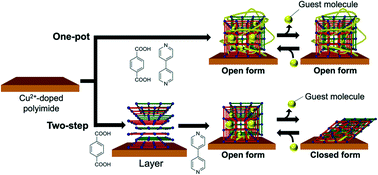Exploration of structural transition phenomenon in flexible metal–organic framework formed on polymer substrate†
Abstract
Control of structural transitions in flexible metal–organic frameworks (MOFs) on a substrate is crucial for controlling their properties for the development of MOF-based applications. In this study, we investigate the structural transition of directly formed flexible MOF crystals on a metal ion-doped polymer substrate. Utilizing hydrolyzed polymer substrates results in the formation of MOF crystals with no structural transition by the adsorption/desorption of guest molecules in their pores. Results suggest that the polymer chains of the substrate are entangled in the obtained MOF crystals, resulting in MOF crystals showing no structural transition by the adsorption/desorption of guest molecules in the pores. By controlling the temperature for the hydrolysis reaction of the polymer substrate, the number of polymer chains entangled with MOF crystals decreases, resulting in a dynamic structural transition of the resulting MOF crystals on the substrate. These results provide insights into the effect of the polymer substrate on the properties of MOF crystals on a two-dimensional substrate.

- This article is part of the themed collection: Crystal Growth


 Please wait while we load your content...
Please wait while we load your content...